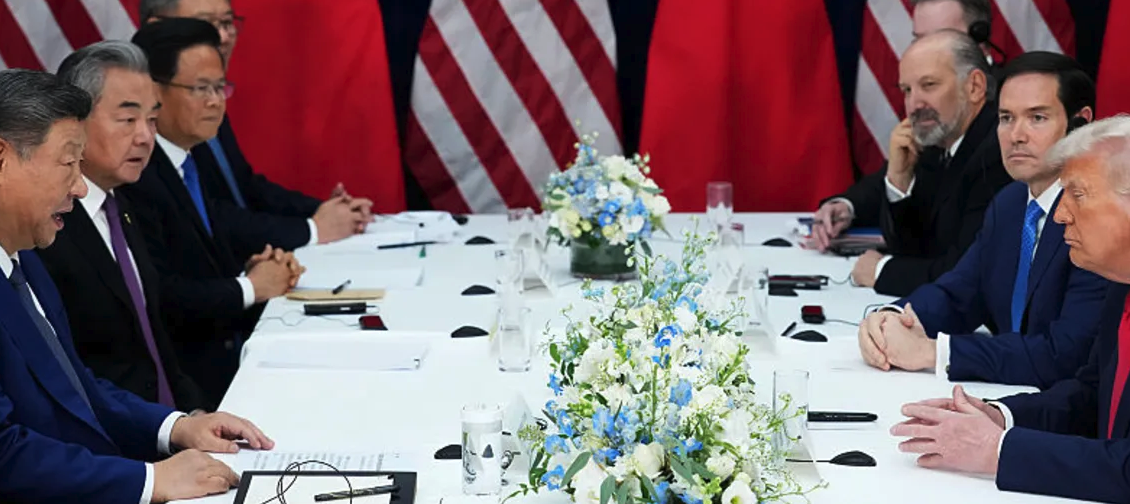President Donald Trump and Chinese President Xi Jinping emerged from a high-stakes meeting touting agreements on tariffs and export controls that amount to a tangible de-escalation of the contentious trade war between the two superpowers.
But many details about what was achieved remain unclear, while other key sticking points in the U.S.-China trade relationship appear not to have come up at all. The overall U.S. tariff rate on Chinese imports, meanwhile, will stay at a historically high level.
The agreements struck during the meeting in Busan, South Korea, do not amount to a comprehensive trade deal — though Trump claimed after the meeting that one would be ready to sign “pretty soon.”
He nevertheless hailed the summit with Xi as “amazing,” and rated it a 12 out of 10.
It was the two leaders’ first face-to-face meeting in six years. They spoke for one hour and 40 minutes.
Tariffs, fentanyl, rare earths and soybeans
The top-line outcomes include an agreement by the U.S. to immediately cut fentanyl-related tariffs on China in half, to 10% from 20%.
Trump told reporters on Air Force One after the meeting that he believes Xi is “going to work very hard to stop the flow” of the addictive opioid fentanyl and its precursor chemicals into the U.S. China has repeatedly promised to reduce fentanyl trafficking to the U.S., but has been accused by experts of not following through.

Trump did not provide additional details. A Chinese Commerce Ministry spokesperson said in a translated statement that “both sides reached consensus on issues such as cooperation in fentanyl control,” without elaborating.
Trump said that the overall tariff rate on Chinese goods will fall to 47% from 57%.
The tariff cut addresses “a key Chinese grievance,” said Han Shen Lin, China director at advisory firm The Asia Group, showing that “Beijing’s efforts to curb exports of fentanyl precursors, long unrecognized by Washington, are finally being acknowledged.”
Trump and Beijing also confirmed that China agreed to pause recently announced export controls on its valuable rare earth minerals for one year.
Those controls were announced on Oct. 9, prompting a furious reply from Trump, who threatened to hike tariffs on China by 100% starting Saturday.
The U.S. is dropping that tariff threat, Trump confirmed on Air Force One. He added that he believes the one-year postponement of the Chinese export controls will be “routinely extended.”
But the Chinese Commerce Ministry’s statement says only that Beijing will suspend the measures for a year, and then “study and refine specific plans.”
China also made no mention of other export control measures it had imposed earlier in the year, which remain in place.
Chinese companies control the majority of the global supply chain for rare earths, which are critical for producing a range of products from semiconductors to missiles. Beijing has ramped up restrictions on exports of critical minerals over the last two years, with a particular focus on limiting their use for military purposes by other countries.
“China’s leverage in rare earths and critical minerals processing will continue to surface episodically, effectively capping any escalation in bilateral tensions,” Louise Loo, head of Asia economics at Oxford Economics, said in a note Thursday.
Trump also said “tremendous amounts” of U.S. soybeans and other farm products will be purchased by China “starting immediately.”

China has been the top buyer of U.S. soybeans. Earlier this year it halted all purchases of the staple crop for months amid the tit-for-tat tariff war, costing American farmers billions of dollars in lost revenue.
Ahead of the Trump-Xi summit, China-owned COFCO bought three U.S. soybean cargoes for December and January shipment, equating to about 180,000 metric tons of product — though experts note that is a fraction of prior years’ purchases during the autumn harvest. By comparison, in October 2024 China bought nearly 6 million tons of U.S. soybeans, according to USDA data. For all of 2024, China bought nearly 27 million tons.
Soybeans are not specifically mentioned in the Chinese Commerce Ministry’s statement, though it says both sides reached consensus on “expanding agricultural trade.”
U.S. tariff investigations on China’s maritime and shipbuilding industries, and Beijing’s countermeasures, will also be delayed for one year, the Chinese government said after the meeting.
Trump said he will be going to China in April, followed by Xi’s trip to the U.S., without specifying a timeline for his Chinese counterpart.
Left unclear: Nvidia chips, TikTok, Russian oil, Taiwan
Multiple key issues went unaddressed in the meeting, Trump said.
On the sale of Nvidia’s chips to China, Trump said the two sides had discussed “a lot of chips,” but not the most advanced Blackwell chips. “They are going to be talking to Nvidia and others about taking chips,” he said.
Taiwan was not part of the discussion, Trump said.
The two leaders also avoided the subject of Chinese purchasing of Russian oil, a financial lifeline to the Kremlin as it continues to wage war in Ukraine.
“Ukraine came up very strongly,” Trump said, but “we didn’t really discuss the oil.”′
Trump also gave no hint that he and Xi had struck a deal to keep the popular social media app TikTok from going dark in the U.S.
China’s government said it would “work with the U.S. to properly resolve issues related to TikTok.”

Global stocks were lower and gold prices rose 1.2% as investors assessed the ramifications of the trade truce, which comes after several months of economic confrontation.
While the trade truce is “welcome news,” any indication of addressing underlying structural matters of concern is missing — such as China’s industrial excess capacity and non-market economy practices — said Wendy Cutler, senior vice president at Asia Society Policy Institute.
That means that the truce is “fragile and tensions are certain to heat up again,” Cutler added.
‘Partners and friends’
Before the meeting, the two leaders struck a conciliatory tone, with Trump calling Xi “an old friend” with whom he has a “very good relationship,” and Xi stressing that China’s economic growth ambitions would not undermine Trump’s vision to “Make America Great Again.”
Tensions between the world’s two economic superpowers have been on a boil this year. The latest escalation came this month, with Beijing export controls and Washington threatening to ban software-powered exports to China.
The U.S. had in recent days shared details about deals they hoped to achieve with China – from restricting the flow of fentanyl to the U.S. to TikTok’s divestiture from its Beijing-based parent ByteDance. Tariffs, tech curbs and rare earths were also on the table for discussion.
Heading into the meeting, Xi shook hands with Trump at the photo-op at Gimhae Air Base in Busan, urging that Washington and Beijing be “friends and partners” in his opening remarks.

Sitting across the table from Trump, the Chinese leader said it was a “great pleasure” to meet the U.S. president for the sixth time, adding that it was only “normal” for the two economic superpowers to have “frictions now and then.”
“China’s development goes hand in hand with your vision to Make America Great Again,” Xi said, according to a readout by the Chinese foreign ministry.
That conciliatory tone marked a notable shift from Xi’s meeting with the former U.S. President Joe Biden late last year, during which the speech highlighted more “inevitable competition” between the two countries, said Yue Su, principal economist at the Economist Intelligence Unit.
While the agreement still lacks a “strong structural foundation” and could easily be reversed, both sides are likely to stick with it in the near term to signal goodwill, Su added.
source: cnbc.com









